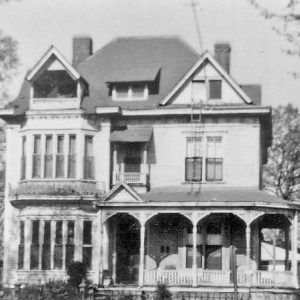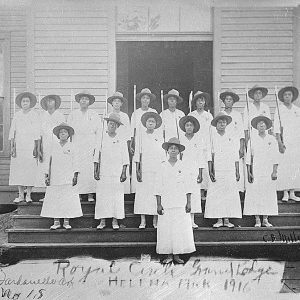calsfoundation@cals.org
Supreme Royal Circle of Friends of the World
aka: Royal Circle of Friends
The Supreme Royal Circle of Friends of the World, also known as the Royal Circle of Friends (RCF), was an African-American fraternal organization founded in 1909 in Helena (Phillips County). The organization was founded to supply insurance to the African-American population but was also dedicated to the moral, physical, social, and economic welfare of its members. Men and women were equal members. From the beginning, the RCF grew rapidly across the Southern states and soon spread across the nation. In 1944, the membership was quoted by a Chicago, Illinois, newspaper as being in excess of 100,000.
Dr. Richard A. Williams was the founding Supreme President and held that position until his death in 1944. Williams was born in Forrest City (St. Francis County) on September 13, 1879. He attended grade school in Forrest City, followed by further education at Danville Industrial High School in Danville, Virginia, and Arkansas Baptist College in Little Rock (Pulaski County). Following college graduation in 1896, he returned to Forrest City and taught in the black public school. At nineteen, he enrolled in Meharry Medical College in Nashville, Tennessee, and afterward practiced medicine in Knoxville, Tennessee. In 1905, he moved his practice to Helena.
The first recruitment meeting of the RCF was held in Helena September 1–3, 1909. The joining fee was $2.50, which included a physical examination. Dues were $1.00 a quarter, and $300 was paid at the death of a member. Other benefits included sick pay from one to five dollars a week. The RCF also supplied a distinctive headstone for members, featuring a lion sitting atop a triangle with the letters RCF in the points of the triangle. By the end of 1909, the RCF had 510 members. In 1910, Williams started a newspaper, the Royal Messenger, published twice a month at a cost to subscribers of one dollar a year. By 1911, there were 300 lodges, called circles, scattered throughout Arkansas, Alabama, Mississippi, Kentucky, and Oklahoma.
In about 1915, the Helena World newspaper reported that RCF membership was 30,000. The RCF had loaned $29,500 to members; had $46,000 in mortgages, real estate, and capital; and had paid out $200,000 in benefits. By this time, circles were established in nine states and had grown beyond the South to Ohio and Illinois. The organization was located in a three-story brick building at 608 Elm Street in Helena that contained a printing press and offices, parlors, a spacious auditorium, and a plant to manufacture regalia to sell to RCF circles.
Supreme conferences for all circles were held annually. In 1915, the supreme conference was held in Memphis, Tennessee, and the central organization chartered a special train to take members from Helena to Memphis. Local circles were encouraged to hold social events, and the national organization, at one time, announced that if a circle did not get together for Thanksgiving, it would be fined a nickel per member.
By 1918, the organization had outgrown its Helena facilities, and Williams moved operations to Chicago. In Chicago, the group built its Supreme Temple and expanded facilities. In 1921, the RCF opened two hospitals for African Americans, one in Memphis and the other in Little Rock. Members received free care at the hospitals. The Little Rock facility, Royal Circle of Friends Hospital, was a fifty-bed hospital located at 12th and Chester. By 1926, the bed capacity of the Little Rock hospital was reduced to thirty-five beds. In 1927, the hospital took over the J. E. Bush Memorial Nurses’ Training School and operated nurses’ training at the 12th and Chester location. The hospital was last listed in a Little Rock city directory in 1934.
In 1928, the Royal Messenger was merged with a St. Louis, Missouri, newspaper, becoming the Standard News-Royal Messenger. Membership dues increased slightly over the years but still remained low for the benefits provided. Although the organization moved to Chicago, it kept it ties to Arkansas, and, in 1928, six of the supreme officers were from Arkansas, including attorney Scipio A. Jones of Little Rock.
Dr. Williams died on September 27, 1944. The Chicago Defender had reported that the RCF was doing very well with more than 100,000 members and over $500,000 in assets, but this may not have been accurate, for on October 12, 1947, the RCF was in bankruptcy. The Supreme Temple was auctioned off as part of the liquidation of assets.
During the operations of the RCF, its members were served well, and the headstones furnished by the organization can still be seen in many Arkansas cemeteries.
For additional information:
Hamilton, G. P. Beacon Lights of the Race. Memphis: F. H. Clark & Brothers, 1911.
Rice, Mitchell F., and Woodrow Jones Jr. Public Policy and the Black Hospital: From Slavery to Segregation to Integration. Westport, CT: Greenwood Press, 1994.
Royal Messenger. May 25, 1910. Available at the Arkansas State Archives, Little Rock, Arkansas.
Walls, Edwina. “Some Extinct Black Hospitals of Little Rock and Pulaski County.” Pulaski County Historical Review 34 (Spring 1986): 2–13.
Carolyn Yancey Kent
Jacksonville, Arkansas
 Royal Circle of Friends Hospital
Royal Circle of Friends Hospital  SRCFW Women
SRCFW Women 




I found a cemetery named Bufferin Cemetery in North Louisiana. There were about seven headstones, and three of them had the emblem of RCF. I researched and found this organization incredibly interesting. The name on the headstones are Corian Colston (died 1-27-1923), Louvenia Carter (died 8-25-1925), and Jim Taylor (died 4-8-29). They all also had “Lily White” and “Circle No. 1320” on them. These were pretty much in the middle of nowhere.
I recently found a lost cemetery in Hensley in the woods that has around twenty Royal Circle of Friends members buried in it.
I have a tombstone that has the name Gretchen Coulter Williams, died November 2, 1923. It has the symbol on it. I found it in the ground behind my barbershop several years ago. I was told that a print shop was here and also a man-made tombstone. It had a chip in the corner so I assumed that’s why it was discarded. I’ve tried to find family members in the area but no luck. There is an African American family in the area with the Coulter name but no history of her.
My grandson and his friends were adventuring on some trails and stumbled across some old headstones. They found these very interesting. One of them had Supreme Royal Circle of Friends of the World on them, with a triangle symbol with lion on top.